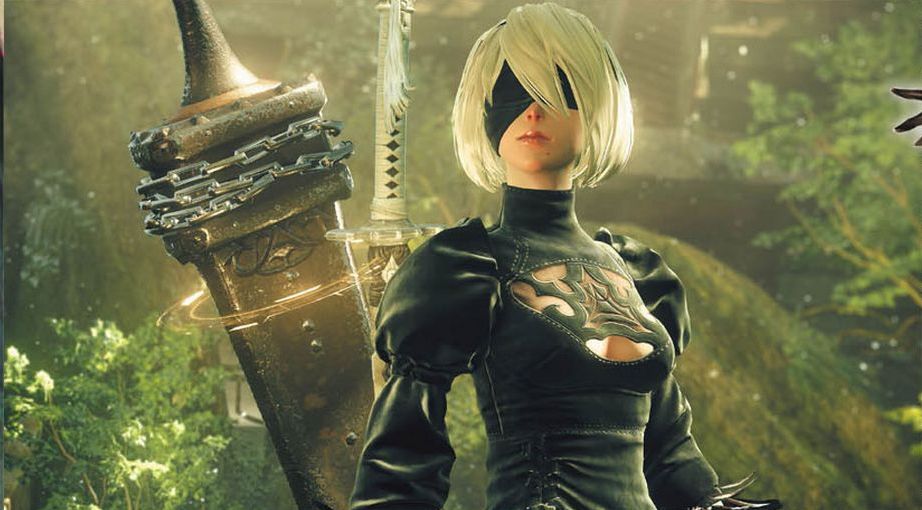The Brilliant Blend of Narrative and Gameplay Mechanics in ‘Nier: Automata’

Reed Pake ’19 / Emertainment Monthly Staff Writer
It’s quite rare when a video game comes along and takes full advantage of the medium’s narrative potential. Acclaimed developer Platinum Games and auteur Yoko Taro have achieved this with their newest title Nier: Automata through blending game mechanics and storytelling in unconventional ways.
Nier: Automata is an open-world hack-and-slash game about the post-apocalypse. In the distant future, aliens invade Earth with an army of robots to take over the planet. Humans flee to the moon and create humanoid androids called YorHa to fight back and reclaim their planet. The player is put in the shoes of three androids: 2B, 9S and A2 throughout the campaign. 2B and A2 specialize in combat whereas 9S is a technology wiz and a talented hacker. Although the narrative may sound trite on paper, the unorthodox way Taro tells it makes the game very unique from other games in the genre.

WARNING: SPOILERS AHEAD
Often referred to as “ludonarrative dissonance,” many games suffer from a stark disparity between gameplay and storytelling. Some of my favorite titles have engaging storylines, interesting characters, fun gameplay mechanics and immersive worlds, but they seldom find ways to meld all of these moving pieces together into something cohesive. For example, Uncharted’s lead character, Nathan Drake, is written to be a plucky, charismatic, and genuinely lovable hero. However, throughout the series the player spends the most time with him mowing through an endless swarm of human enemies. Since Nate is characterized as a heroic goofball in cutscenes, it’s disorienting to play him as a mass-murderer in gameplay sections. Automata, on the other hand, rarely drops the ball when it comes to weaving narrative and gameplay mechanics, allowing the game to never break its illusion.
The game tasks the player to murder as many machines as possible in order to save Earth. These robots are said to be emotionless and thoughtless and are only programmed to kill. As the plot progresses, the protagonist come in contact with conscious machines complete with feelings, goals, desires, and other human traits that cause the protagonists and players to feel guilty when destroying robots as they shriek for their lives to be spared. Haunting. The game doesn’t paint the protagonist as heroes and then force players to go on a guilt-free murder spree without consequences. The game causes players to think about every action they make in the game world and the effects they have on its inhabitants.

The game mechanics themselves also weave into the narrative with fascinatingly subversive results. After a wild and heart-thumping prologue, I was greeted with a black screen. I put the controller down, as many other games have conditioned me to do so, as I waited for the load screen to end. It didn’t. The game then prompted me to make an input on my controller which then caused my HUD to fade into view. This was to set-up brightness. I then was prompted to go into the volume settings in order to hear my companion 9S’s voice. As I brought up the volume slider, his voice slowly became more audible. In regards to the user interface, it simultaneously serves as the player’s means to navigate menus and the protagonist’s operating system. When the protagonist’s software begins to glitch out during the tail-end of the game, so does the player’s HUD. I found it genius that the developers were able to tie such a mundane video game mechanic such as navigating menus into the narrative.
Characters also consistently break the fourth wall in ways that add to the world-building rather than breaking immersion. During one section of the game, I was forced to backtrack down a long stretch of hallways. I audibly groaned right before 9S chipped in and complained. “Back this way again? What a pain.” Even cheekier is when one of the token tutorial NPCs explain why the game’s map is so difficult to navigate and ties it to the protagonist’s operating system. The game’s subtle self-awareness is joyous, rather than obtrusive, which is a nice change of pace from games such as Undertale and Deadpool which shove irony down your throat (even though I love these titles.) Lastly, when the mechanics become “game-y” such as eating a raw fish to replenish health, the protagonist dies as mackerel are poisonous to androids. Hilarious.

It has been years since I’ve played a game as creative as Nier: Automata that really pushes the boundaries of video game interactivity and storytelling. Hopefully, this is the game that encourages more developers to make a more conscious effort to eliminate ludonarrative dissonance. If you are looking for the thinking man’s JRPG hack-and-slash that subverts player expectations at every turn, look no further. Yoko Taro and Platinum Games have you covered with this gem of a game.
Glory to Mankind.
Wow cuz this is extremely good|excellent|great} work! Congrats and keep it up.